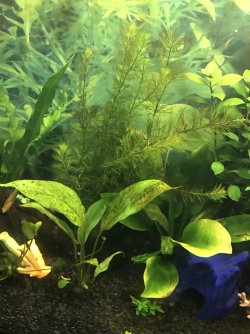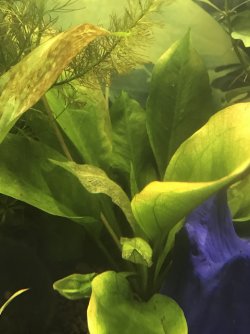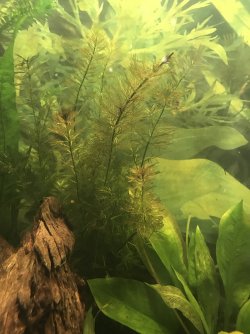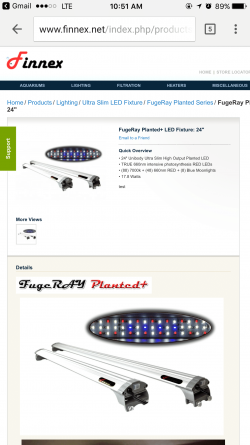sagealbright
New Member
- Joined
- Jan 2, 2017
- Messages
- 3
- Reaction score
- 0
Hello everyone,
This is my first time posting on the site. I have been using it for a few months since I started my tank to find answers but I'm at my wits end with my aquarium and could really use some advice.
I currently have a 40 gallon tall tank. My pump/filter is a Ovation-700, an air stone, and I have Fluval Plant & Shrimp stratum as the substrate. My tank have all live plants, no plastic, 3 pieces of driftwood, and two store bought fish hide outs. My tank finished it's cycle the beginning of January and I began with 4 Cory cats as my first fish. Since I started the tank I have had a problem with the pH being high. I want south american cichlids in my tank but every time I add any, they die in 3-5 days. I've already had 4 gold rams die, an angelfish, and 2 blue rams. All were not in the tank at the same time of course. When the rams died I decided to try the angel fish instead. I currently have the 4 Cory cats, 1 angelfish, and 4 Mystery Snails. I use the Tetra Easy Strips to test my water. pH levels have stayed at 8.4 no matter what I have done to bring them down. They will come down for a day and then shoot back up to 8.4. The water is also up around 300 KH alkaline. Originally someone at my local aquarium supply store told me to try Seachem Acid Buffer. He told me to put it directly into the tank. My fish were eating it when I would put it in so I stopped using it, I figured it probably wasn't good for them to eat... Then another employee at the same store told me to use distilled water since the pH and KH in my tap water is extremely high. I did about two 10 gallon water changes in two weeks with the distilled water and still had no luck. Then yesterday I went back out to my local aquarium store again and the man that I talked to told me that distilled water should never go in my tank. He said to use the Seachem acid buffer but to mix it with the new water in a bucket until I get my desired pH, then add it to the aquarium. I tried that last night with about a 15% water change and the pH did come down, but then this morning it was back up between 7.8-8.4. I have been using Seachem Prime whenever I add new water. Along with Seachem Flourish and API CO2 Booster for my plants as directed on the package. Also, I do not have the funds to produce RO water right now... so that is out of the question.
On top of all this my plants are dying. The man at the aquarium store that I talked to yesterday said it is because of my light. A different employee from the same store told me that I could use the 24in Finnex Planted Plus for my 36in tank. He told me that with how bright it was my plants would have plenty of light. Now, I am getting algae build up on some of my plants and they are turning brown. One of my swords actually fell apart yesterday and all the leaves were floating in the tank. The only plants in my tank that are being affected by this are the ones in the middles of the tank, which are directly under the light. Because of this the man I talked to yesterday said this is happening because my light it too intense. He was trying to get me to buy a $300 Current light instead. I'm not sure whether to believe him or not. He could have just been trying to make a sale. Either way, I need to figure out what is going on in my tank that is making my plants die.
If anyone could please help me out with this pH issue along with my plant problem I would REALLY appreciate it. I have invested hundreds of dollars in this already and do not want to throw in the towel, but I fear that I will if I can't keep any south american cichlids or plants alive. That was the only reason I started an aquarium to begin with.
This is my first time posting on the site. I have been using it for a few months since I started my tank to find answers but I'm at my wits end with my aquarium and could really use some advice.
I currently have a 40 gallon tall tank. My pump/filter is a Ovation-700, an air stone, and I have Fluval Plant & Shrimp stratum as the substrate. My tank have all live plants, no plastic, 3 pieces of driftwood, and two store bought fish hide outs. My tank finished it's cycle the beginning of January and I began with 4 Cory cats as my first fish. Since I started the tank I have had a problem with the pH being high. I want south american cichlids in my tank but every time I add any, they die in 3-5 days. I've already had 4 gold rams die, an angelfish, and 2 blue rams. All were not in the tank at the same time of course. When the rams died I decided to try the angel fish instead. I currently have the 4 Cory cats, 1 angelfish, and 4 Mystery Snails. I use the Tetra Easy Strips to test my water. pH levels have stayed at 8.4 no matter what I have done to bring them down. They will come down for a day and then shoot back up to 8.4. The water is also up around 300 KH alkaline. Originally someone at my local aquarium supply store told me to try Seachem Acid Buffer. He told me to put it directly into the tank. My fish were eating it when I would put it in so I stopped using it, I figured it probably wasn't good for them to eat... Then another employee at the same store told me to use distilled water since the pH and KH in my tap water is extremely high. I did about two 10 gallon water changes in two weeks with the distilled water and still had no luck. Then yesterday I went back out to my local aquarium store again and the man that I talked to told me that distilled water should never go in my tank. He said to use the Seachem acid buffer but to mix it with the new water in a bucket until I get my desired pH, then add it to the aquarium. I tried that last night with about a 15% water change and the pH did come down, but then this morning it was back up between 7.8-8.4. I have been using Seachem Prime whenever I add new water. Along with Seachem Flourish and API CO2 Booster for my plants as directed on the package. Also, I do not have the funds to produce RO water right now... so that is out of the question.
On top of all this my plants are dying. The man at the aquarium store that I talked to yesterday said it is because of my light. A different employee from the same store told me that I could use the 24in Finnex Planted Plus for my 36in tank. He told me that with how bright it was my plants would have plenty of light. Now, I am getting algae build up on some of my plants and they are turning brown. One of my swords actually fell apart yesterday and all the leaves were floating in the tank. The only plants in my tank that are being affected by this are the ones in the middles of the tank, which are directly under the light. Because of this the man I talked to yesterday said this is happening because my light it too intense. He was trying to get me to buy a $300 Current light instead. I'm not sure whether to believe him or not. He could have just been trying to make a sale. Either way, I need to figure out what is going on in my tank that is making my plants die.
If anyone could please help me out with this pH issue along with my plant problem I would REALLY appreciate it. I have invested hundreds of dollars in this already and do not want to throw in the towel, but I fear that I will if I can't keep any south american cichlids or plants alive. That was the only reason I started an aquarium to begin with.






